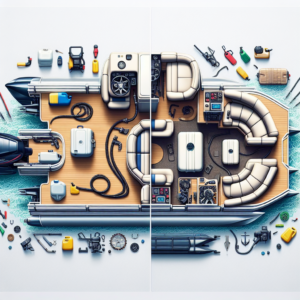Introduction to Refueling Pontoon Boats
Pontoon boats are popular and often used for recreational activities such as fishing, cruising or partying at the lake. Understanding how to put gas in a pontoon boat is an essential part of maintaining its performance and longevity.
Understanding the Basics of Pontoon Boat Design
A pontoon boat is engineered with two or more cylindrical-shaped pontoons or floats made of aluminum and attached to a flat deck. Depending on the size of the boat, the fuel system may be located under the deck or in the rear of the boat.
The Importance of Proper Fueling Techniques
It is essential to use proper fueling techniques to avoid accidents and ensure the safety of those on board. An improperly fueled pontoon can cause fuel spills, fires and explosions, which can be hazardous and cause severe damages to the environment.
Safety Precautions Before Refueling
Before refueling, it is crucial to turn off the boat’s electrical system entirely. This includes but is not limited to the engine, onboard lights, and radios. It is also essential to check weather conditions and avoid fueling during high wind or stormy weather. A grounding wire should be used to prevent the possibility of an accidental spark when refueling.
Types of Fuel Systems in Pontoon Boats
Pontoon boats can have either portable or permanent fuel tanks. Portable fuel tanks are typically made from high-density polyethylene and come in various sizes depending on the boat’s fuel consumption and tank storage space. These tanks are detachable and can be removed and replaced when empty or when refueling is required.
Permanent fuel tanks, on the other hand, are built into the pontoon boat’s structure during construction. These tanks are typically made from aluminum and are positioned in a specific location where they can be accessed for refueling. The size of the tank is determined by the manufacturer, which also considers the maximum weight-supporting capacity of the boat and the amount of fuel the engine needs to run.
The fuel system design of a pontoon boat can impact the refueling process. Boats with portable fuel tanks can be refueled on deck, on trailers, or on shorelines, while boats with permanent tanks require moving to a fueling dock. Portable fuel tanks are recommended for smaller pontoon boats, while larger boats may benefit from permanent tanks and a built-in fueling system. Boats that frequently travel long distances are better suited for permanent fuel tanks, while those that remain near the shore can easily use portable tanks.
How Fuel System Design Influences Refueling Process
The fuel system design of a pontoon boat can significantly influence the refueling process. Portable fuel tanks can be safely refueled without going to the marina, while boats with permanent fuel tanks must be strategically positioned at a fueling dock. Portable tanks are easy to store and can be replaced when empty, while permanent fuel tanks are built into the boat and require maintenance and inspection to ensure they are functioning properly.
When using portable fuel tanks, the boat owner has the freedom to choose where to refuel and how much fuel to purchase. Boats with permanent fuel tanks must be positioned at fueling docks, and the boat owner may be limited in the amount of fuel they can purchase due to the fueling dock’s pump system. Therefore, fuel system design is a crucial consideration for pontoon boat owners, and the decision must be based on their boating needs and lifestyle.
| Portable Fuel Tanks | Permanent Fuel Tanks |
|---|---|
| Easy storage and portability | Built into the boat structure |
| Refuel on deck, trailers, or shorelines | Refuel at fueling docks |
| Varying sizes based on fuel consumption | Manufacturer determines the size |
| Detachable and replaceable when empty | Requires maintenance and inspection |
Understanding the types of fuel systems in pontoon boats is crucial for smooth and hassle-free refueling. Portable tanks are a popular choice for smaller boats and boat owners who want more flexibility in refueling, while permanent fuel tanks are a permanent feature of the boat’s structure intended for long-distance travel and frequent use.
Preparing to Refuel Your Pontoon Boat
Locating Your Nearest Marina or Fueling Station
Before you start refueling your pontoon boat, it’s important to know where to find a marina or fueling station that can accommodate your vessel’s needs. Not all locations will have the necessary equipment to fill your pontoon’s tank, so it’s important to do some research beforehand. Check online directories and boating forums to find recommendations for fuel stop locations that can handle filling your boat’s tank.
Checking the Fuel Level and Capacity
Always check your pontoon boat’s fuel level and capacity before heading to the fueling station. This will ensure that you have enough storage space for the fuel you’ll need and help you gauge how much you’ll need to spend. Your boat’s owner’s manual should provide information on fuel capacity and the type of fuel that’s recommended. Make sure to follow the manufacturer’s guidelines, as using the wrong type of fuel or exceeding capacity can cause damage to your boat’s engine or fuel system.
Gathering Necessary Equipment for Refueling
To make the fueling process go smoothly, it’s important to have all the necessary equipment on hand. This might include gas cans, fuel filters, funnel, rags or towels, and safety gear like gloves and goggles. Double-check your boat’s manual to ensure you have all the required equipment before starting the refueling process. This will save you time and ensure that you’re not caught off-guard with missing or improperly stored equipment.
Step-by-Step Refueling Process
Approaching the Dock Safely
Before you dock, cut your engine and slowly drift towards the dock. Use dock lines to tie the pontoon boat to the dock securely. Set fenders to protect your pontoon boat from damage when docked. Double-check that there are no electrical cords or fuel hoses in the water before docking.
Securing the Pontoon Boat Before Fueling
Make sure all passengers are off the boat before approaching the fuel dock. Also, confirm that all sources of ignition, such as cigarettes or open flames, are extinguished. If you’re using portable fuel tanks, remove them from the pontoon boat before filling. If you have a built-in fuel tank, remove the fuel cap and set it aside in a clean, dry area.
The Correct Procedure for Filling the Tank
Step 1: Gauge Your Tank
Make sure you know the tank capacity before adding fuel. Use a dipstick or gauge to check the level of fuel already in the tank
Step 2: Ground the Fuel Tank and the Pontoon Boat
Electricity and water don’t mix. So, to avoid any hazards, ground both the fuel tank and the pontoon boat before you fuel.
Step 3: Put the Nozzle in the Tank
Hold the nozzle firmly and insert it into the fuel tank. Make sure the nozzle is deep enough into the tank to avoid any splashing of fuel.
Step 4: Start Filling the Tank
Keep the nozzle firmly in place and begin filling the tank. Do NOT overfill the tank. Use a funnel to avoid any spills.
Step 5: Stop Filling When Tank Is Full
When the tank is filled, release the trigger on the nozzle to stop the flow of fuel. Wipe away any spills with a clean cloth.
Troubleshooting Common Refueling Issues
If the fuel doesn’t make its way into the tank, check the vent on the gas tank to ensure it’s not clogged. Sometimes air pressure may build up inside the fuel tank. If so, open the fuel tank cap and pause to let the pressure subside a bit before trying to add more fuel.
| Step | Description |
|---|---|
| Step 1 | Gauge Your Tank |
| Step 2 | Ground the Fuel Tank and the Pontoon Boat |
| Step 3 | Put the Nozzle in the Tank |
| Step 4 | Start Filling the Tank |
| Step 5 | Stop Filling When Tank Is Full |
| Section | Key Points |
|---|---|
| Approaching the Dock Safely |
|
| Securing the Pontoon Boat Before Fueling |
|
| The Correct Procedure for Filling the Tank |
|
| Troubleshooting Common Refueling Issues |
|
Post-Refueling Checks and Maintenance
After refueling your pontoon boat, it’s essential to perform a few checks and maintenance tasks to ensure optimal performance and safety.
Inspection for Leaks or Spills
Before taking your boat back on the water, inspect the area around the fuel system for any signs of leaks or spills. Check beneath the fuel filters, fuel lines, and around the fill cap. If you notice any leaks or spills, take necessary steps to address them promptly. Clean up any fuel spills immediately to reduce the risk of fire.
Proper Disposal of Fuel Containers and Cleanup
Now that you’ve refueled your pontoon boat, it’s crucial to properly dispose of any fuel containers used during the process. If possible, recycle the containers or take them to a hazardous waste disposal facility. Never dump fuel containers in the trash or release any fuel into the environment.
It’s also important to thoroughly clean up any fuel spills or drips around the fuel system and on your pontoon boat. Use an absorbent material such as kitty litter to soak up fuel and dispose of it properly.
Maintenance Tips to Ensure Fuel System Integrity
To keep your pontoon boat’s fuel system in tip-top shape, it’s essential to perform regular maintenance. This includes changing the fuel filter every season, checking fuel lines for cracks or leaks, and inspecting the fuel tank for corrosion or damage.
When not in use, it’s a good idea to turn off the fuel valve to prevent any fuel from leaking. Also, store your fuel containers in a cool, dry place away from any heat sources or direct sunlight.
Remember, proper maintenance of your pontoon boat’s fuel system will not only ensure optimal performance but also help keep you and your passengers safe on the water.
Frequently Asked Questions
- How often should I change the fuel filter on my pontoon boat?
- Can I use regular unleaded gasoline in my pontoon boat?
- What should I do if I notice fuel leaking from my pontoon boat?
- What are some common fuel system issues on pontoon boats?
You should change the fuel filter on your pontoon boat every season or every 100 hours of operation.
Most pontoon boats are designed to run on regular unleaded gasoline. However, you should consult your owner’s manual for specific fuel requirements.
If you notice fuel leaking from your pontoon boat, turn off the engine and gas supply immediately. Investigate the source of the leak and take necessary steps to repair it before operating your boat again.
Common fuel system issues on pontoon boats include clogged fuel filters, cracked or leaking fuel lines, and corroded fuel tanks. Regular maintenance and inspection can help prevent these issues.







